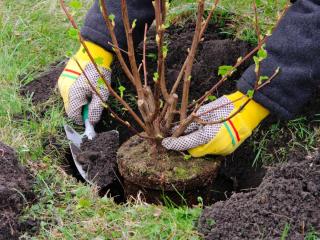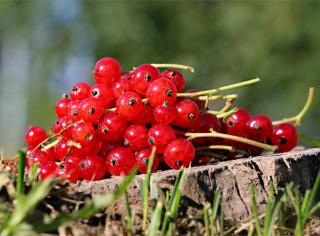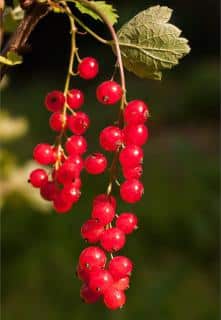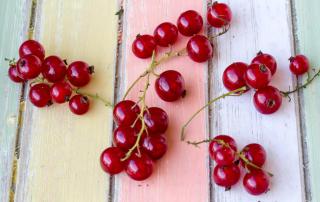

Red currant produces marvelous small currant berries in summer.
Key facts about Currant
Name – Ribes grossularia
Family – Grossulariaceae
Type – fruit tree
Height – 40/50 in (100/120 cm)
Exposure – full sun
Foliage: deciduous – Flowering: end spring – Harvest: end summer→mid-fall
Sometimes these are called gooseberries. Planting, pruning and care must all follow good practices to increase the harvest.
It is a good idea to plant currant bushes in fall or until spring, while avoiding frost spells.
 If you’re planting in spring, water more regularly during the first months, because your shrub will need more water to develop its roots over the summer months.
If you’re planting in spring, water more regularly during the first months, because your shrub will need more water to develop its roots over the summer months.
Whatever the exposure, favor rich soil and feel free to add soil conditioner to the ground when planting.
If properly settled in, caring for currant bushes is quite easy.
The right time to prune a red currant bush is towards the end of winter, ideally during the months of February-March. The weather should be rather mild and dry, with no risk of freezing.
Although one-year old branches or canes might bear fruit, they’ll really bear a lot more in the second and third years.
Try to keep around 9 canes on your currant shrub (give or take a few):
With a little practice, you can easily tell the 2 and 3 year-old canes apart: older ones have more wrinkly bark, and the bark color is different, too. Fresh shoots are hard to miss, of course: they look brand new!
Red currant bushes need water to bear fruit well.
Most relevant is to water regularly and spread a layer of mulch at the foot of the shrub to retain soil moisture in summer.
Although it isn’t mandatory, adding berry tree fertilizer will significantly increase quantity and quality of your currant.
Currants generally resist diseases well, especially if you’ve chosen disease-resistant varieties.
 The best way to avoid diseases on your red currant bushes is to provide them with required nutritional needs in spring thanks to compost or soil conditioner such as manure and seaweed.
The best way to avoid diseases on your red currant bushes is to provide them with required nutritional needs in spring thanks to compost or soil conditioner such as manure and seaweed.
Preventive treatment with Bordeaux mixture at the end of winter also helps avoid a good deal of fungus.
 Harvesting currants depends on the variety and can happen between June and August.
Harvesting currants depends on the variety and can happen between June and August.
The worst enemy of currant is birds, they can consume an entire harvest in minutes. That is why protecting the currant with a net is required.
You can expect around 4 to 12 lbs (2 to 5 kg) per plant.
Fruits that are on the inside of the bush need more time to ripen and can be harvested later.
 This common fruit shrub is easy to grow.
This common fruit shrub is easy to grow.
It is a favorite for its fruits that tickle our tongue buds, eaten fresh or cooked in clafoutis, jams or jellies for breakfast.
Give it the space it needs to grow, plant it in a cool place where the air circulates well.
Thanks to its bushy aspect and the translucent red color of its fruits, it looks very nice and fits in any garden.
If needed, treat against powdery mildew or black spot disease but be careful to only use organic products, because you’ll be eating the fruits…